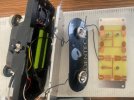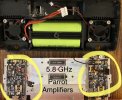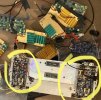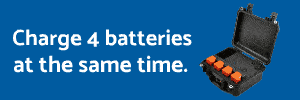| Antenna | Type | Connector | Freq. | dBi | Range 1 | Range 2 | Range 3 | Link |
| Autel SC Stock Antenna Blade | Omni | RP-SMA | 2.4/5.8 | unknown | 11,941 | 12,433 | 12,618 | 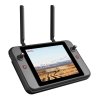 |
| Autel RC Stock Whip Antenna | Omni | RP-SMA | 2.4 | unknown | 9,891 | 9,975 | 9,237 | 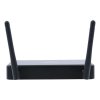 |
| Generic Netgear Router Antenna | Omni | SMA | 2.4/5.8 | unknown | 6,215 | 6,266 | 6,267 | |
| Unbranded Wifi Antenna Blade | Omni | RP-SMA | 2.4/5.8 | 6dBi | 10,991 | 12,139 | 11,679 | 6dBi Dual Band Omni-Directional WiFi Antenna |
| Kaunosta Wifi Whip Antenna | Omni | RP-SMA | 2.4 | 22dBi | 7,943 | 8,011 | 3,289 | Kaunosta High Gain 22dbi Omni-Directional Antenna |
| Supertbat Wifi Whip Antenna | Omni | RP-SMA | 2.4/5.8 | 12dBi | 14,615 | 14,951 | 15,001 | Superbat High Gain WiFi Antenna |
| Covert Drones/Titan Drones Whip | Omni | RP-SMA | 2.4 | 9dBi | 11,163 | 12,401 | 11,782 | 9 dBi Whip Antenna Kit |
| Covert Drones/Titan Drones 2.4G Directional Antenna | Directional | RP-SMA | 2.4 | 22dBi | 3,455 | 3,961 | 6,880 | Titan 24/58 |
| Covert Drones/Alientech Duo II | Directional | RP-SMA | 2.4/5.8 | 28-30dBm | 2,400 | 2,318 | 2,547 | Alientech DUO II Amplified |
| Unbranded 4g/wifi Mobile Antenna | Omni | SMA | 2.4/3g/4g | 12dbI | 4,022 | 3,911 | 4,386 | 12DBi 4G 3G 2.4G Omni Directional Antenna |
Tests were ran one after another from mid-morning to early afternoon in excellent weather conditions of high 80s to low 90s in clear skies with no wind with relative humidity low. Flight path was over terrain with moderate elevation change beginning over urban setting but transitioning to rural setting approximately 4000 feet into flight. A small airport with no airspace restriction was located 500 feet south of the drones flight path around 6600 feet. ADS-B was active. Signal interference should be considered to be moderate to high.
The smart controllers position was static for eacy flight test mounted to a tripod and elevated 4 feet and angled 45 degrees for operation. Its geospatial location was in a residential neighborhood with significant tree and structures around, behind, and in front of the the cotroller including directly opstructing the LOS to the drone. Location was also nearby a commercial downtown area of a small community with the flight path going directly over it. []
Whip and blade antenna position was set to 90 degrees perpendicular to the horizon and connected directly to the controller with 90 degree adapters (when required).
Directional Antennas were attached via one 18 inch adapter cable. Antenna position was static via tripod and was mounted on top of a Pan/Tilt Head at approximately 5'6" elevation with the angle being adjusted regularly through flight to the angle estimated to be along the aircrafts trajectory.
Range was determined by running the same preprogrammed mission of flight in a straight line direction at 250 AGL at 22mph. Eastbound trajectory. The Range is defined as how many feet away from the takeoff location the drone was at when it lost communication with the controller and automatically began returning to home. I did not make any assessment of signal strength or account for when image degradation began in-flight. Of note is that the flight altitude was maintained along the same plane from start to finish but the drones altitude was not static. Due to dynamic terrain, the altitude varied greatly along the flight between 120 AGL and approximately 560 AGL. The controller was static at 0 AGL with the altitude at range 10,000 feet and on at 120 AGL.
Needless to say I am very disappointed with the Alientech Antennas performance. But, the Titan Drones directional antenna also grossly underperformed expectations so, being as I did no calculation of required angle and only estimated the best angle to aim the antenna, I will not rule out the possibility that I was wildly wrong in my estimation and neither antenna was aligned optimally towards the drone.
With the exception of the Netgear antennas and the mobile network antennas, it certainly seems that omnidirectional whip antennas are what the drone and controller seem to like the best. A dBi rating of 6-12dBi also seems optimal. It also does not seem that cost plays a factor nor does prestige of a name brand. The Kaunostica whip I am considering to be anomalous for a few reasons. One, Im suspicious of the 22dBi rating as I cannot find any peer competitor item for sale anywhere which also has an equivalent or similar dBi rating. Im skeptical that it is a unicorn item that only one company in the world manufacturers. Secondly, despite my suspicions of the dBi rating, Im leaving the possibility on the table that the dBi is accurate for the antenna and that I also was not able to properly align the antennas envelope with the drone just as I was not able to do with the directional antennas. That I also recorded one outlier result with these antennas as I did also with the Titan Directional antenna also supports this.
However if this is true, then that is a condemnation of the Alientech antenna as it recorded extremely consistent results on all 3 tests unlike the Kaunostica whips and Titan Directional. These results are also not consistent with its angle being manually adjusted arbitrarily. If the $10 Kaunosticas are legit, then that means the $500 boosted antenna is either defective, or junk.
If anyone is aware of how you can covert a powered antenna from using pcb-style directional panel antennas to RP-SMA outputs for whip antennas, I would love to hear about it. But I dont have much hope that it is. That being said:
For Sale Alientech Duo II Amplified Dual Band Antenna System. Like new, Less than 6 hours of flight. Still under manufacturer warranty. Comes with Smart Controller adapters. Retails for $525.00. Make an offer if interested
Last edited:




